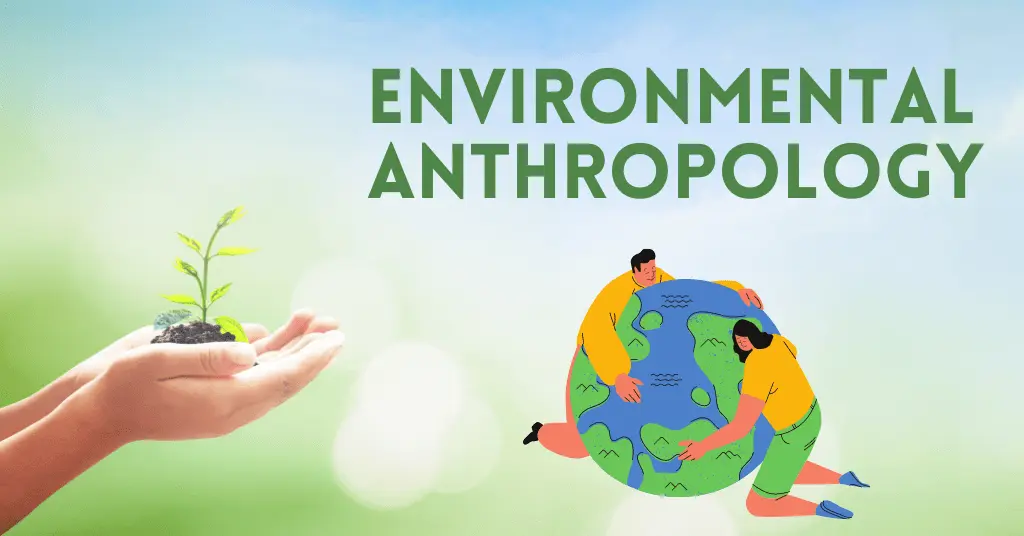AI Answer Evaluation Platform Live Now. Try Free Answer Evaluation Now
Environmental Anthropology
Environmental anthropology is an interdisciplinary field of study that focuses on the relationships between people and their environments. It seeks to understand how cultures and societies interact with their natural surroundings, how environmental changes affect human communities, and how humans, in turn, impact their environment. Environmental anthropology draws on concepts and methodologies from anthropology, ecology, biology, geography, and other disciplines to address questions about how humans adapt to and shape their environments, how environmental knowledge is transmitted across generations, and how cultural practices and beliefs influence environmental decision-making. The field is concerned with issues such as environmental conservation, climate change, sustainability, and human-environment interactions in both contemporary and historical contexts.

- Significance of anthropological perspective in the relationship between humans and environment
- History of Environmental Anthropology
- Goals of Environmental Anthropology
- Relationship between Humans and Environment
- Environmental Issues and Solutions
- Future directions of Environmental Anthropology
- Conclusion
- FAQs about Environemtal Anthropology
- See Also
- References
- Further Reading
- List of Academic Programs in Environmental Anthropology
Significance of anthropological perspective in the relationship between humans and environment
Studying the relationship between humans and the environment from an anthropological perspective is important for several reasons:
- Understanding human-environment interactions: Anthropologists help us to understand how humans interact with and shape their environment. This can provide insights into how humans have adapted to different environments over time and how their activities have impacted those environments.
- Examining cultural practices and beliefs: Anthropologists study how culture shapes human-environment interactions. By examining cultural practices and beliefs, anthropologists can shed light on why certain societies prioritize certain environmental values over others.
- Promoting sustainability: Anthropologists play a critical role in promoting sustainable practices by studying how humans have traditionally managed their environments and by working with communities to identify and implement sustainable solutions.
- Addressing environmental challenges: Anthropologists can help us to address environmental challenges by providing insights into the cultural and social dimensions of environmental issues. For example, they can help to identify cultural barriers to conservation efforts or work with communities to develop culturally appropriate responses to environmental disasters.
History of Environmental Anthropology
Environmental anthropology has its origins in the mid-20th century, emerging from the intersection of anthropology, ecology, and conservation biology. As a discipline, it evolved in response to growing concerns about environmental degradation and the impacts of human activities on the natural world.
Key figures in the development of environmental anthropology include Julian Steward, who is often credited as one of the founders of the discipline. Steward’s work in the 1940s and 1950s focused on the cultural ecology of indigenous societies and their relationships with their environments. Another important figure is Roy Rappaport, whose work in the 1960s and 1970s focused on the interactions between culture and ecology in Papua New Guinea. Other influential scholars in the field include Eric Wolf, Marvin Harris, and Mary Douglas, among others.
Over time, environmental anthropology has evolved and expanded to address a wide range of environmental issues, from climate change and biodiversity loss to environmental justice and sustainability. The field has also become increasingly interdisciplinary, drawing on insights and methodologies from ecology, biology, geography, and other disciplines.
Today, environmental anthropology encompasses a wide range of research topics and approaches, from the study of traditional ecological knowledge and indigenous resource management practices to the analysis of the political and economic factors that shape environmental decision-making. As environmental challenges continue to grow in urgency and complexity, environmental anthropology will likely continue to evolve and adapt to address new and emerging issues.
Goals of Environmental Anthropology
The goals of environmental anthropology are to understand the complex relationships between humans and the environment, to promote sustainable practices, and to develop effective strategies for addressing environmental challenges.
Environmental anthropology differs from other environmental disciplines in that it focuses on the cultural and social dimensions of environmental issues. While ecology and conservation biology focus primarily on the biological and ecological aspects of environmental problems, environmental anthropology examines the cultural practices and beliefs that shape human-environment interactions.
Some examples of research questions that environmental anthropologists may ask include:
- How do cultural beliefs and practices shape attitudes towards the environment?
- How have different societies historically adapted to and managed their environments?
- How do cultural practices and beliefs affect the success of conservation efforts?
- How do economic and political factors influence environmental decision-making?
- How do indigenous communities manage and use natural resources sustainably?
- How do environmental changes affect cultural practices and identities?
- How can we promote sustainable practices that are culturally appropriate and socially just?
Relationship between Humans and Environment
Humans and the environment have a complicated and multidimensional interaction. Human societies have always been deeply intertwined with their natural surroundings, relying on the environment for resources and adapting to its fluctuations and changes. However, the relationship between humans and the environment has also been fraught with conflict and exploitation, with humans often overusing and damaging the environment for short-term gain.
One of the key factors that shape human-environment interactions is culture. Cultural practices and beliefs shape how humans view and interact with the environment, influencing everything from resource use and management to conservation efforts. For example, indigenous communities around the world have developed unique cultural practices and knowledge systems that allow them to sustainably manage their natural resources over time.Traditional ecological knowledge, also referred to as indigenous people’ knowledge and customs accumulated through many generations, is often based on deep observation of the environment and a profound understanding of its interconnected systems.
Politics and economics also play a significant role in shaping the relationship between humans and the environment. Political systems and policies can either encourage or discourage sustainable practices and conservation efforts. For example, government policies that provide incentives for renewable energy production can help to reduce reliance on fossil fuels and mitigate climate change. On the other hand, policies that prioritize economic growth over environmental protection can lead to overexploitation of natural resources and environmental degradation.
Economic factors such as globalization and consumerism also have a significant impact on human-environment interactions. The demand for cheap goods and services often leads to unsustainable resource use and pollution, as well as the exploitation of workers and communities in resource-rich areas. For example, the global palm oil industry has been linked to deforestation, biodiversity loss, and human rights abuses in countries like Indonesia and Malaysia.
Different cultures also interact with the environment in different ways, reflecting the unique histories, values, and beliefs of each society. For example, many indigenous cultures have deep spiritual connections to the environment, viewing natural resources as sacred and practicing rituals to honor and protect them. In contrast, some Western cultures view the environment primarily as a resource to be exploited for economic gain, with little consideration for the long-term consequences of this exploitation.
Environmental Issues and Solutions
Environmental anthropologists study a range of environmental issues, including climate change, biodiversity loss, deforestation, pollution, and water scarcity. These issues are often intertwined with social, cultural, and economic factors, and require interdisciplinary approaches to address them effectively.
One way that environmental anthropologists contribute to solutions to environmental problems is by working with communities to develop culturally appropriate and socially just solutions. This involves understanding local knowledge and practices, engaging with stakeholders, and developing strategies that reflect the unique needs and values of each community. For example, environmental anthropologists may work with indigenous communities to document traditional ecological knowledge and develop sustainable resource management plans that honor indigenous values and beliefs.
Environmental anthropologists may also contribute to solutions by engaging with policymakers and other stakeholders to promote sustainable practices and policies. By bringing a cultural and social perspective to environmental issues, they can help to highlight the complex dynamics that shape human-environment interactions and develop strategies that address these dynamics effectively. For example, environmental anthropologists may collaborate with policymakers to develop conservation policies that reflect the needs and values of local communities, or to promote renewable energy sources that are culturally and economically appropriate.
Successful collaborations between environmental anthropologists and other disciplines are often interdisciplinary in nature, drawing on the strengths of different fields to address complex environmental problems. For example, collaborations between environmental anthropologists and ecologists can help to develop sustainable resource management plans that are based on a deep understanding of ecological systems and human-environment interactions. Collaborations between environmental anthropologists and geographers can help to develop spatially informed strategies for addressing environmental challenges, while collaborations between environmental anthropologists and sociologists can help to understand the social and cultural factors that shape human-environment interactions.
One example of a successful collaboration between environmental anthropologists and other disciplines is the work of the Alliance of Indigenous Peoples of the Archipelago [Aliansi Masyarakat Adat Nusantara] (AMAN) in Indonesia. AMAN is a network of indigenous communities that works to protect indigenous lands and resources, promote traditional ecological knowledge, and advocate for indigenous rights. Environmental anthropologists have played a key role in supporting the work of AMAN by documenting traditional ecological knowledge, developing sustainable resource management plans, and advocating for indigenous rights at the national and international levels.
Future directions of Environmental Anthropology
As environmental challenges become increasingly complex and urgent, environmental anthropology is poised to play an important role in shaping our understanding of these issues and developing effective solutions. Future directions for environmental anthropology may include:
- Engaging with climate change: Climate change is one of the most pressing environmental issues of our time, and environmental anthropology can contribute to our understanding of the social and cultural dimensions of climate change. This includes exploring how cultural values, political systems, and economic structures shape responses to climate change and how communities can adapt and mitigate its impacts.
- Examining the intersections of environmental and social justice: Environmental justice is a critical issue that intersects with social justice, and environmental anthropology can help to highlight the ways in which environmental problems disproportionately affect marginalized communities. This includes examining how race, gender, and class intersect with environmental issues and how environmental policies and practices can be made more equitable.
- Incorporating Indigenous knowledge and perspectives: Indigenous knowledge and perspectives offer unique insights into human-environment relationships and sustainable resource management practices. Environmental anthropology can help to incorporate and elevate Indigenous perspectives in environmental research and policy-making, particularly as Indigenous communities continue to face threats to their lands and resources.
- Promoting interdisciplinary collaboration: Addressing complex environmental challenges requires interdisciplinary collaboration between scientists, policymakers, and communities. Environmental anthropology can contribute to these collaborations by bringing a cultural and social perspective to environmental issues and by advocating for more holistic and integrated approaches to environmental problem-solving.
Environmental anthropology may contribute to our understanding of environmental issues in a number of ways. First, environmental anthropology provides a cultural and social perspective on environmental issues, highlighting the ways in which human values, beliefs, and practices shape human-environment interactions. Second, environmental anthropology emphasizes the importance of local knowledge and practices, which can inform more sustainable resource management practices. Third, environmental anthropology advocates for more inclusive and participatory approaches to environmental decision-making, which can ensure that the needs and values of local communities are taken into account.
Interdisciplinary collaboration is essential for addressing environmental challenges, as no single discipline has all the answers. Environmental anthropology can contribute to interdisciplinary collaborations by working with other fields such as ecology, geography, and sociology, among others, to develop more holistic and integrated approaches to environmental problem-solving. This includes exploring the intersections of social and ecological systems, incorporating local knowledge and practices, and promoting more inclusive and participatory approaches to environmental decision-making.
Conclusion
In conclusion, the study of the complicated link between people and the environment is explored in the multidisciplinary discipline of environmental anthropology. Environmental anthropology emphasizes the cultural and social dimensions of environmental issues, including how human values, beliefs, and practices shape human-environment interactions, and the importance of local knowledge and practices in sustainable resource management. Key figures in the development of environmental anthropology include Julian Steward, Roy Rappaport, and Philippe Descola, and the field has evolved over time to incorporate new perspectives and interdisciplinary collaborations.
Environmental anthropology is important because it provides a unique perspective on environmental issues, emphasizing the importance of culture, politics, and economics in shaping human-environment relationships. Environmental anthropologists may contribute to solutions to environmental problems by advocating for more inclusive and participatory approaches to environmental decision-making, incorporating Indigenous knowledge and perspectives, and promoting interdisciplinary collaborations. Successful collaborations between environmental anthropologists and other disciplines include working with ecologists, geographers, and sociologists to develop more holistic and integrated approaches to environmental problem-solving.
FAQs about Environemtal Anthropology
See Also
References
- Dove, M. R. (2015). Environmental anthropology. John Wiley & Sons.
- Gadgil, M., & Guha, R. (1995). Ecology and equity: The use and abuse of nature in contemporary India. Routledge.
- Ingold, T. (1992). Culture and the perception of the environment. In The perception of the environment: Essays on livelihood, dwelling and skill (pp. 32-53). Routledge.
- Low, S. M., & Lawrence-Zúñiga, D. (Eds.). (2003). The anthropology of space and place: Locating culture (Vol. 1). Blackwell Publishing.
- Rappaport, R. A. (1979). Ecology, meaning, and religion. Richmond: North Atlantic Books.
- Steward, J. H. (1955). Theory of culture change: The methodology of multilinear evolution. University of Illinois Press.
- Bélanger, P. (2017). Ecologies of Power: Counter Mapping the Logistical Landscapes and Military Geographies of the U.S. Department of Defense. MIT Press.
- Descola, P. (2013). Beyond nature and culture. University of Chicago Press.
- Dove, M. R., & Carpenter, C. (Eds.). (2008). Environmental Anthropology: An Historical Reader. Blackwell Publishing.
- Human Ecology. (n.d.). Springer.
- Tsing, A. L. (2015). The Mushroom at the End of the World: On the Possibility of Life in Capitalist Ruins. Princeton University Press.
Further Reading
- Ecologies of Power: Counter Mapping the Logistical Landscapes and Military Geographies of the U.S. Department of Defense by Pierre Bélanger
- “Environmental Anthropology: An Historical Reader” edited by Michael R. Dove and Carol Carpenter
- “The Mushroom at the End of the World: On the Possibility of Life in Capitalist Ruins” by Anna Lowenhaupt Tsing
List of Academic Programs in Environmental Anthropology
- Portland State University. Undergraduate and Master’s Program in Anthropology
- Utrecht University. M.Sc. Cultural Anthropology: Sustainable Citizenship
- Stanford University. Environmental Anthropology Cluster
- University of South Florida. Department of Anthropology Undergraduate and Graduate Programs in Applied Anthropology
- University College London. M.Sc. Anthropology, Environment, and Development
- University of California, Davis. Graduate Area of Specialization: Environmental Anthropology
- University of Georgia. Ecological and Environmental Anthropology. PhD. Integrative Conservation (ICON) Program. Undergraduate Certificates in Sustainability, Environmental Ethics, and Conservation Ecology.
- University of Kent. M.A. in Social Anthropology: Humanitarian and Environmental Crises
- University of Pennsylvania. Environmental Anthropology
- University of Maine. B.A. Anthropology: Human Dimensions of Climate Change. M.A. in Anthropology and Environmental Policy Program
- University of Maryland. Ecological and Environmental Anthropology. B.A., B.S., MA.A., and Ph.D. programs
- University of Texas at San Antonio. Ph.D. in Environmental Anthropology
- Yale School of Forestry and Environmental Sciences and Department of Anthropology. Joint Doctoral Degree Program in Anthropology and the Environment



